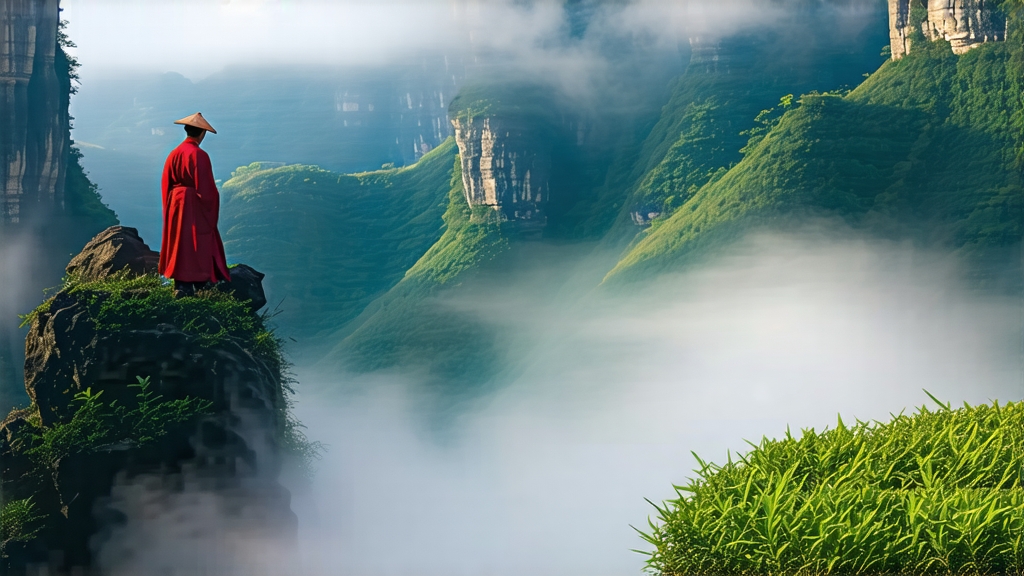
If oolong is the most dramatic chapter in the epic of Chinese tea, then Da Hong Pao from the Wuyi Mountains of northern Fujian is its undisputed tragic hero—royal yet rebellious, scarred yet sublime. To the uninitiated, the name simply means “Big Red Robe,” but behind those three modest syllables lies four centuries of court intrigue, scholarly verse, cliff-side peril, and the alchemy of rock, fire, and leaf. This article invites international tea lovers to step beyond the souvenir tin and meet the living legend in its geological, historical, and sensory dimensions.
-
Myth into History
The oldest origin tale tells of a Ming-dynasty scholar who, while hurrying to the capital for the imperial exam, collapsed with fever in the Wuyi gorge. Monks from the nearby Tianxin Temple brewed leaves picked from four stunted bushes clinging to the cliff; the candidate revived, passed the exam with highest honors, and returned in gratitude, draping his crimson official robe over the bushes to protect them from the mountain wind. Whether parable or fact, the story anchors Da Hong Pao’s identity: tea that restores, honors, and commands reverence. By the early Qing, the Kangxi Emperor had elevated it to “tribute” status; caravans carried roasted leaves along the Mei-ling pass to Beijing, 1,200 km away, where the court prized its ability to hold flavor after repeated infusions better than greener, more delicate southern oolongs. In 1972, Mao Zedong gifted 50 g of mother-tree Da Hong Pao to U.S. President Nixon, inadvertently revealing how scarce the original bushes had become—only six survive today on the 400-meter-high Jiulongke cliff, their life now safeguarded by UNESCO World Heritage status. -
Terroir: When Rock Becomes Flavor
Wuyi’s Danxia landform, a purple-red sandstone laid down 100 million years ago, weathers into shallow, mineral-rich soils that force tea roots to struggle, concentrating aromatic compounds. The gorge funnels humid subtropical air upward, forming a constant mist that filters sunlight into a soft, diffused glow. Locals speak of “yan yun” (rock rhyme), an elusive texture that translates as a vibrating, almost metallic finish felt on the sides of the tongue and the back of the throat. Scientists credit the high potassium and fluoride content in the substrate, but drinkers simply know it as the taste of Wuyi itself—stone turned into liquor. -
Varietal Genealogy
Da Hong Pao is not a single cultivar but a stylistic summit reachable by several genetic paths. The original “mother trees” belong to the Qi Dan cultivar, now protected and no longer harvested. In the 1980s, agronomists selected three close offspring—Bei Dou #1, Qi Dan (cloned), and Que She (Sparrow Tongue)—to propagate the genetic lineage without touching the ancient bushes. Today, commercial Da Hong Pao falls into three tiers:- Pure pedigree: 100 % Qi Dan or Bei Dou #1 from the core 60 km² scenic reserve.
- Blended yancha: a skillful marriage of 3–5 Wuyi cultivars such as Rou Gui (cassia) and Shui Xian (narcissus) to approximate the mother-tree profile.
- Aromatic style: lightly roasted, floral versions aimed at newcomers, often sold as “hua xiang Da Hong Pao.” Each tier obeys the same roasting discipline, yet delivers different balances of orchid, honey, and igneous stone.
-
Craft: The Eight-Act Drama
Pluck: only the middle 3–4 leaves are taken in late April, when the leaf’s cellular walls thicken enough to withstand the marathon roast.
Wither: trays are set under the morning sun for 20 minutes, then moved to shaded corridors where mountain breeze reduces moisture to 65 %.
Yao Qing (tumbling): the leaves are shaken in 1.2-meter-wide bamboo drums for 6–8 cycles, bruising edges to initiate oxidation while keeping the center green.
Sha Qing: a 280 °C wok kill-green arrests oxidation at 30–40 %, the sweet spot for oolong.
Rolling: forty minutes of alternating pressure and release extrude aromatic oils, forming the signature strip-and-twist shape.
Roast #1 (primary): charcoal embers at